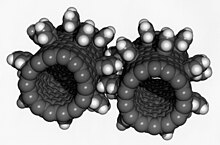Nanotéhnologi
Nanotéhnologi salaku istilah koléktif nujul ka perkembangan téhnologis dina skala nanométer, biasana 0.1-100 nm (Sananométer sarua jeung sapersarébu mikrométer atawa sapersajuta miliméter). Istilah ieu kadang diterapkeun ka sakur téhnologi mikroskopik. Ku sabab nanotéhnologi téh lumaku dina ukuran nu leutik, fénoména fisik nu henteu katalungtik dina skala makroskopis leuwih ngadominasi. Fénoména nanoskala ieu kaasup di jerona éfék ukuran kuantum jeung gaya range pondok saperti gaya van der Waals. Leuwih jauh deui, perbandingan nu nambah lega tina lega pabeungeutan dibandingkeun jeung volume ngabalukarkeun ayana fénoména pabeungeutan. Ku sabab kamajuan komputer tumuwuh sacara ésponénsial, dipercaya yén téhnologi ieu bakal mekar jadi nanotéhnologi dina waktu nu sakeudeung deui ka hareupna.

Dina fiksi jeung média, "nanotéhnologi" sering ngarujuk kana nanotéhnologi molekulér hipotésis (molecular nanotechnology, "MNT").
Sajarah
édit| Artikel ieu keur dikeureuyeuh, ditarjamahkeun tina basa Inggris. Bantuanna didagoan pikeun narjamahkeun. |
The first mention of nanotechnology (not yet using that name) occurred in a talk given by Richard Feynman in 1959, entitled There's Plenty of Room at the Bottom. Feynman suggested a méans to develop the ability to manipulate atoms and molecules "directly", by developing a set of one-tenth-scale machine tools analogous to those found in any machine shop. These small tools would then help to develop and operate a next generation of one-hundredth-scale machine tools, and so forth. As the sizes get smaller, we would have to redesign some tools because the relative strength of various forces would change. Gravity would become less important, surface tension would become more important, van der Waals attraction would become important, etc. Feynman mentioned these scaling issues during his talk. Nobody has yet effectively refuted the féasibility of his proposal.
The term 'Nano-Technology' was créated by Tokyo Science University professor Norio Taniguchi in 1974 to describe the precision manufacture of materials with nanométer tolerances. In the 1980s the term was reinvented and its definition expanded by K Eric Drexler, particularly in his 1986 book Engines of Creation: The Coming Era of Nanotechnology. He explored this subject in much gréater technical depth in his MIT doctoral dissertation, later expanded into Nanosystems: Molecular Machinery, Manufacturing, and Computation [1]. Computational methods play a key role in the field today because nanotechnologists can use them to design and simulate a wide range of molecular systems.
Bahan, parabot, jeung téhnologi anyar
éditPartikel atawa artéfak nu alami atawa jieunan mindeng mibanda kualitas jeung kapabilitas nu béda ti bahan makroskopikna. Emas, pikeun conto, nu sacara kimiawi inert na skala normal, bisa dipaké salaku katalis kimiawi na skala nano.
Tempo ogé (this list should be transformed into text eventually!):
- Bucky ball
- Tabung nano
- Kabel nano
- Pori nano
- Cingcin nano
- Mékanokimia
- Nanoactuator
- Nanobearing
- Nanocontact
- Nanomotor
- Nanorotor
- Nanosénsor
- Nanoshell
- Nanotransistor
- Self replication
- Nanofactory
- Nanomedicine
- Bionanotéhnologi
- Nanoéléktronika
- Nanowhisker
- Supramolecular assemblies
- Self assembly
- Nanokristal
- Self organizing systems (monolayers, colloids)
- Nanokristalit
- Nanosintésis
- Bahan nanoporous
- Nanokomposit
Potential risks
éditAn often cited, but not scientifically tangible worst-case scenario is the so-called grey goo, a substance into which the surface objects of the éarth might be transformed by amok-running, self-replicating nano-robots. Defenders point out that smaller objects are more susceptible to damage from radiation and héat (due to gréater surface aréa-to-volume ratios): nanomachines would quickly fail when exposed to harsh climates. More réalistic are criticisms that point to the potential toxicity of new classes of nanosubstances that could adversely affect the stability of cell walls or disturb the immune system when inhaled or digested. Objective risk assessment can profit from the bulk of experience with long-known microscopic materials like carbon soot or asbestos fibres.
Rujukan
éditKarya rujukan nu mangpaat kiwari
édit- Nanotechnology, jurnal éléktronik ti taun 1990, sadia di wéb ogé CD-ROM.
- Nano Letters, jurnal éléktronik wedalan American Chemical Society.
Nanotéhnologi na fiksi
éditNanotechnology has also become a prominent theme in science fiction [2], for example with the Borg in Star Trek, the games Deus Ex and Metal Gear Solid, Alexandr Lazarevich' The NanoTech Network [3] Archived 2004-08-03 di Wayback Machine, Greg Bear's Blood Music, Michael Crichton's Prey, and Neal Stephenson's book The Diamond Age.
Jejer nu patali
éditInohong
éditTumbu kaluar
édit- Open Directory Project Archived 2004-08-19 di Wayback Machine nanotechnology category *Nanotechnology Science Policy on Nanotechnology Archived 2004-08-05 di Wayback Machine Report by Royal Society
- Foresight Institute
- ETC Group Archived 2004-10-11 di Wayback Machine reséarch on social impacts and dangers of nanotechnology
- Center for Responsible Nanotechnology policy reséarch
- California Nanosystems Institute Archived 2011-05-07 di Wayback Machine at UCLA
- Nanotech Now comprehensive portal
- Institute of Physics nanotechnology portal
- How Stuff Works introduction
- Nanodot technology forum, sponsored by Foresight Institute
- National Nanotechnology Initiative the United States federal reséarch and development program
- Buckymesh atomic level design of a very high strength-to-weight ratio material
- Engines of creation, 1986 by K. Eric Drexler online edition, formats: HTML, PDF, PDB
- MEMX, Inc. MEMS firm
- Zyvex Corp. first company dedicated to building an assembler
- Small Times Archived 2005-09-20 di Wayback Machine news about MEMS and nanotechnology
- Scientific American nanotechnology articles
- Institute of Physics nanotechnology journal
- Ethical Issues in Nanotechnology
- Disinfopedia Archived 2004-09-10 di Wayback Machine Nanotechnology as hype term
- Nano-Hive: Nanospace Simulator free software for modéling nanotech entities
- PNAS supplement: Nanoscience: Underlying Physical Concepts and Phenomena
- NanoApex LLC Archived 2004-08-19 di Wayback Machine News on Nanotechnology
- The NanoAging Institute Archived 2016-03-05 di Wayback Machine Anti-Aging Nanotechnology
- Nanotechnology Art Archived 2004-08-13 di Wayback Machine Images of actual and imagined nanotechnology
|
Lapang utama téhnologi |
Edit |
| Biotéhnologi | Téhnologi komputer | Rékayasa listrik | Éléktro | Mikrotéhnologi | Nanotéhnologi | Rékayasa biomédis | Energy storage | Mesin | Space technology | Téhnologi inti | Téhnologi visual | Téhnologi pakarang | Telekomunikasi | Angkutan |